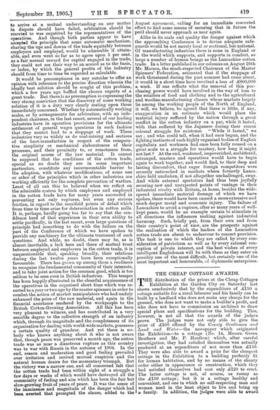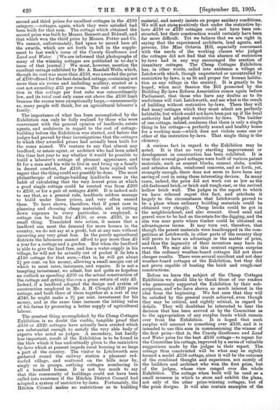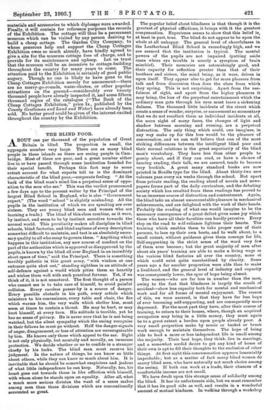T HE distribution of the prizes at the Cheap Cottages Exhibition
at the Garden City on Saturday last shows conclusively that by the expenditure of £150 a cottage suitable for a rural labourer and his family can be built by a landlord who does not make any charge for the ground, who does not want to make a builder's profit, and who does not have to commission an architect to draw special plans and specifications for the building. This, however, is not all that the awards of the judges prove. The judges were not only able to give the prize of £100 offered by the County Gentleman and Land and Water—the newspaper which originated the Exhibition—to a cottage (No. 14, Messrs. Green Brothers and Mr. P. Houfton) which, after careful investigation, they had satisfied themselves was actually produced at an expenditure of not more than £150. They were also able to award. a prize for the cheapest cottage in the Exhibition to a building perfectly fit for human habitation, and by no means of the shanty order either in appearance or construction, which they bad satisfied themselves had cost only £120 to erect. The latter cottage is not, of course, as roomy as the £150 cottage ; but it is a cottage healthy and convenient, and one in which no self-respecting man and woman need in the least object to live and bring up a- family. In addition, the judges were able to award second and third prizes for excellent cottages in the £150 category,—cottages, again, which they were satisfied had been built for that sum. The cottage which obtained the second prize was built by Messrs. Bennett and Bidwell, and that which won the third prize by Messrs. Potter and Co. We cannot, unfortunately, find space to record here all the awards, which are set forth in full in the supple- ment to last week's issue of the County Gentleman and Land and Water. [We are informed that photographs of many of the winning cottages are published in to-day's issue of that journal.] We must, however, mention the excellent cottage exhibited by Mr A Randall Wells, which, though its cost was more than £150, was awarded the prize of £100 offered for the best detached cottage, containing not more than six rooms and including scullery, erected at a cost not exceeding £35 per room. The cost of construc- tion in this cottage per foot cube was extraordinarily low, and its total cost only came out above the £150 limit because the rooms were exceptionally large,—unnecessarily so, many people will think, for an agricultural labourer's family.
The importance of what has been accomplished by the Exhibition can only be fully realised by those who were conversant with the general opinion of landlords, estate agents, and architects in regard to the cost of cottage building before the Exhibition was started, and before the judges had proved by their investigations that the cottages to which they awarded prizes had actually been built for the sums named. We venture to say that alinost any landlord, or estate agent, or architect who had been asked this time last year to say whether it would be possible to build a labourer's cottage of pleasant appearance, and fit for a man and his wife to live in and bring up a family in decent comfort, for £150, would have replied with regret that the thing could. not possibly be done. The most philanthropic of cottage-building landlords were in the habit of calculating that the very lowest price at which a good single cottage could be erected was from £200 to £250, or for a pair of cottages £400. It is indeed safe to say that, as a general rule, landlords seldom manage to build under these prices, and very often exceed them. To have shown, therefore, that if great care in planning and choosing cheap materials, and in cutting down expenses in every particular, is employed, a cottage can be built for £150, or even £120, is no small thing. Translated into action, it means that a landlord can meet the demand for more houses in the country, we do not say at a profit; but at any rate without incurring any very great loss. In the purely agricultural districts the labourers cannot afford to pay more than £5 a year for a cottage and a garden. But when the landlord is able to give the land free, and has a water-supply in his village, he will not be actually out of pocket if he lets a £150 cottage for that sum,—that is, he will get about 211 per cent. on his money, allowing a small margin out of which to meet rates, insurance, and repairs. It is not a tempting investment, we admit, but not quite so hopeless an outlook as spending £250 on the actual construction of the cottage and getting thereon a gross return of only £5. Indeed, if a landlord adopted the design and system of construction employed in Mr. A. H. Clough's £120 prize cottage, and built three of them together at a cost of say £340, he might make a 31 per cent. investment for his money, and at the same time increase the letting value of his farms by procuring a better supply of agricultural labour.
The greatest thing accomplished by the Cheap Cottages Exhibition is no doubt the visible, tangible proof that £150 or £120 cottages have actually been erected which are substantial enough to satisfy the very able body of experts who acted as judges. A secondary, but hardly less important, result of the Exhibition is to be found in the blow which it has undoubtedly given to the restrictive by-laws which at present impede rural housing in so large a part of the country. The visitor to Letchworth sees gathered round the railway station a pleasant red- roofed village, and scattered. on the hills near by, singly or in groups, oUtlying cottages numbering in all a hundred homes. It is not too much to say that this community of buildings could not have been called into existence if the Hitchin District Council had adopted a system of restrictive by-laws. Fortunately, the Hitchin Council makes no "restrictions as to building material, and merely insists on proper sanitary conditions, We will not statespositively that under the restrictive by £150 or £120 cottages could not have been con- structed, but their construction would certainly have been far more difficult. Yet we believe that we are right in, saying that the experienced architects, land agents, and, persons, like Miss Octavia Hill, especially conversant with the needs of the working classes who judged the cottages did. not find that the absence of restrictive by-laws had in any way encouraged the erection of insanitary cottages. The Cheap Cottages Exhibition, has, in other words, called into existence a village at Letchworth which, though unprotected or uncontrolled by restrictive by-laws, is as fit and proper for human habita- tion as any village in the country. It is greatly to be hoped, when next Session the Bill promoted by the Building By-laws Reform Association comes again before Parliament, that those who have any doubts as to its usefulness will visit Letchworth, and see what is the result of building without restrictive by-laws. There they will find. many cottages which they must admit are perfectly habitable, but which could. not have been put up if the local authority had adopted restrictive by-laws. The builder of one cottage, indeed, confesses that there is only a single thing in his cottage—a perfectly sound and healthy home for a working man—which does not violate some one or other of the restrictive by-laws. That single thing is the chimney.
A curious fact in regard to the Exhibition may be noted. It is that no very startling improvement or development in construction has been exhibited. It is true that several good cottages were built of various patent materials, such as cement blocks, cement slabs, uralite and asbestos slabs, reinforced concrete, and so forth, yet, strangely enough, there does not seem to have been any saving of cost in using these interesting devices. In many cases, indeed, the price did not work out so low as the old-fashioned brick, or brick and rough-cast, or the revived hollow brick wall. The judges in the report to which we have referred regret this fact, and attribute it largely to the circumstance that Letchworth proved. to be a place where ordinary building materials could be obtained very cheaply. Cheap bricks could be got in the neighbourhood, and also cement. Good. sand and gravel were to be had on the estate for the digging, and the site was near ports where timber could be obtained. on advantageous terms. It may turn out, therefore, that though the patent materials were handicapped in the com- petition at Letchworth, in other parts of the country they will prove to have an advantage in the matter of price, and thus the ingenuity of their inventors may have its reward. We may also in this context express surprise that the ordinary weather-board. cottages did not show cheaper results. There were several excellent and not dear weather-board cottages at the Exhibition, but they did not prove capable of beating the brick and rough-cast constructions.
Before we leave the subject of the Cheap Cottages Exhibition we should like to thank those of our readers who generously supported the Exhibition by their sub- scriptions, and who have shown so much interest in the idea from the beginning. We feel sure that they will be satisfied by the general result achieved, even though they may be critical, and rightly critical, in regard to details. They will doubtless be interested to hear the decision that has been arrived at by the Committee as to the appropriation of any surplus funds which remain over from the Exhibition. It is hoped that such surplus will amount to something over £150, and it is intended to use this sum in commissioning the winner of the first prize—that is, the County Gentleman and Land and Water prize for the best £150 cottage—to repeat for the Committee his cottage, improved. by a series of valuable suggestions made by the judges in their report. The. cottage thus constructed will be what may be rightly, termed a model £150 cottage, since it will be the outcome, of the combined thought and experience, not merely of the bUilders and architect who won the first prize, but of the judges, whose view ranged over the., Exhibition. The cottage when built will be use as a, small museum in which to store _and. exhibit the plans, not only of the other prize-winning cottages, but of the prize designs. It will also contain examples of the
materiels and accessories to which diploma were awarded. Finally, it will contain for reference purposes the records of the Exhibition. The cottage will thus be a permanent museum which can be visited by any person desiring to build a cheap cottage. The Garden City Company, to whose generous help and support the Cheap Cottages Exhibition owes so much already, have kindly agreed to give a site for the museum cottage free of charge, and to provide for its maintenance and upkeep. Let us trust that the museum will be an incentive to cottage-building throughout the country for many years to come. The attention paid to the Exhibition is certainly of good public augury. Though no one is likely to have gone to the Cheap Cottages Exhibition merely for amusement—there are no merry-go-rounds, water-chutes, or other popular attractions on the ground—considerably over twenty thousand people have already inspected it, and some fifteen thousand copies of the catalogue (" The Book of the Cheap Cottages Exhibition," price ls., published by the County Gentleman and Land and Water) have already been sold. No better proof could be given of the interest excited throughout the country by the Exhibition.












































 Previous page
Previous page